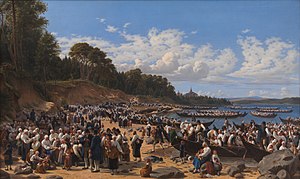| Church-Goers Arriving by Boat at the Parish Church of Leksand on Siljan Lake | |
|---|---|
 | |
| Artist | Wilhelm Marstrand |
| Year | 1853 (1853) |
| Medium | oil on canvas |
| Dimensions | 130.5 cm × 215 cm (51.4 in × 85 in) |
| Location | Danish National Gallery, Copenhagen |
Church-Goers Arriving by Boat at the Parish Church of Leksand on Siljan Lake, Sweden (Danish: Kirkefærd i Dalarne i Sverige. Til Leksands sognekirke i Dalarne kommer folket i deres store kirkebåde over Siljansøen om søndagen til gudstjeneste), is an oil on canvas painting by Wilhelm Marstrand. It is in the collection of the National Gallery of Denmark.
History
On 8 June 1850, Marstrand was married to Margrethe Christine Weidemann (1824-1867) in Frederiksberg Church. The ongoing First Schleswig War made it impossible to travel south on their honeymoon. On the recommendation of Hans Christian Andersen, a friend of Marstrand, they chose instead to go to Dalarna in Sweden.
Back from his honeymoon, Marstrand received a commission from C.- A. Thomsen for a large painting of this scene for the Danish National Gallery. In his book I Sverige (1851), Andersen had described the colourful tableau with the church-goers:
|
In Danish |
In English |
In July 1851, Marstrand therefore returned to Lake Siljan. In Leksand, he created numerous preparatory sketches for the large painting. It was completed in early 1853. The painting was ready for the opening of the annual Charlottenborg Spring Exhibition on 31 March 1853.
Description
In Wilhelm Marstrand – A cosmopolitan artist caught in a vortex of images (2020), Jesper Svenningsen has described the painting as a highlight in Marstrand's production. He observes: "In contrast to virtually all of Marstrand’s earlier depictions of life, he chose here to eschew anecdote and suppress any urge to caricature or beautify. Instead, he has chosen a panoramic scene and gone on to orchestrate the crowd with a tautness of composition more reminiscent of a battle scene than of a rural population assembling on a perfectly ordinary Sunday morning."
References
- Madsen, Karl (1905). Wilhelm Marstrand 1807-1873. Kunstforeningen. pp. 168–. ISBN 1172123985.
- "Wilhelm Marstrand" (in Danish). Dansk Biografisk Leksikon. Retrieved 27 October 2021.
- "Church-Goers Arriving by Boat at the Parish Church of Leksand on Siljan Lake, Sweden". Statens Museum for Kunst. Retrieved 8 June 2022.
- "Wilhelm Marstrand – A cosmopolitan artist caught in a vortex of images". perspectivejournal.dk (in Danish). Retrieved 9 June 2022.
External links
- Kirkefærd i Dalarne i Sverige. Til Leksands sognekirke i Dalarne kommer folket i deres store kirkebåde over Siljansøen om søndagen til gudstjeneste at kulturarv.dk
- Church-Goers Arriving by Boat at the Parish Church of Leksand on Siljan Lake, Sweden at SMK
- Source
- Source
| Wilhelm Marstrand | |
|---|---|
| Paintings | |
| People |
|